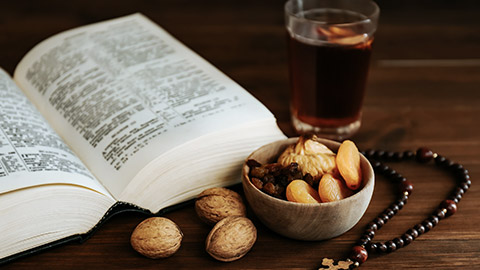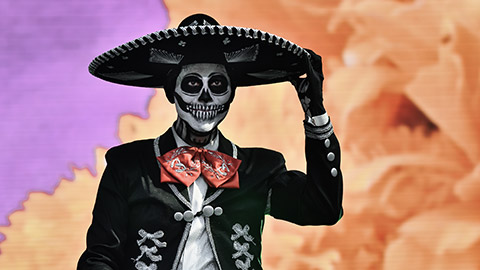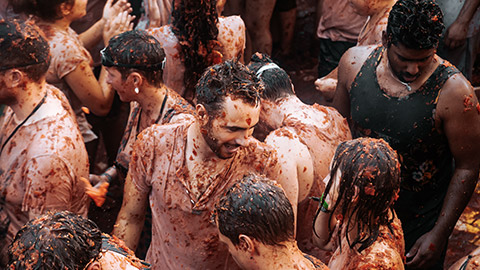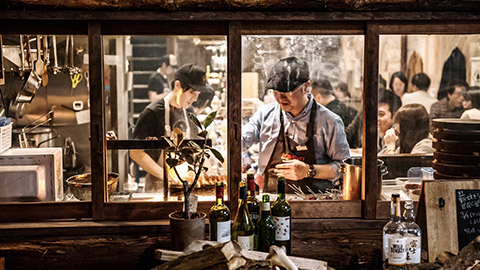Watch
Many religions have specific rules around food, restricting what may and may not be eaten by followers. The reasons for these rules are varied and have a big effect on the ingredients and dishes on offer in different parts of the world.
Some religions forbid certain types of food, or restrict when they may be eaten. They may also demand certain foods be eaten at certain times of the day or of the year.

Exercise 9
Just for fun, have a go at this quiz on religious foods.
World Religions and Symbolic Food Quiz - By CGMFan1 (sporcle.com)
Let’s look at an example of how religion and food interact to change what people eat:
Case Study: Christianity and Lent

Christianity is the world’s largest religion, claiming 2.4 billion followers worldwide and is around 2,000 years old. There are many different branches and versions of this religion, but all have the Bible as their holy book. It is a monotheistic religion (belief in only one god) which follows the teachings of Jesus of Nazareth (Christ). The Christian year is divided into different seasons, each of which has its own distinct customs and traditions. One such season is Lent.
Lent
Lent is the period of 40 days preceding the major Christian festival of Easter. It is supposed to represent the 40 days of Christ’s withdrawal into the desert leading up to his crucifixion. Traditionally it is a period of fasting – abstaining from food and festivities, though nowadays most adherents do not actually fast for the whole 40 days. Instead they may decide to give up a particular vice or a favourite food. For them, it is a test of self-discipline and mirrors Christ’s sacrifice and deprivation in the desert.
Lent and Pancakes
The day before Lent starts is called “Shrove Tuesday”, and for many this has become “Pancake Tuesday”. Because people are supposed to either fast, or abstain from many pleasures during Lent, the day before Lent is seen as a celebration and a day to use up many of the food items which would not last the period of abstinence (e.g. meat, fish, butter, eggs, milk). One dish which could use up some of these ingredients – milk, eggs and butter is pancakes, just needing the addition of flour. (bbc.co.uk, n.d.)
Pancake day itself is thought to have originated as a pagan festival (as are many Christian festivals, including Christmas), which celebrated the end of winter and the beginning of springtime. (Holzwarth, 2018) (Where Is Pancake Day Celebrated? - 6 Steps, n.d.)
Pancake Traditions
Britain is one place where Pancake Tuesday is commonly observed. One tradition on this day is to hold pancake races, where people gather to hold races through the streets, flipping pancakes in a pan as they run.
British pancakes for Pancake Tuesday are usually thin and served simply, sprinkled with sugar and lemon juice.

Exercise 10
Research the topic of religion and food and explore 2 different ways a religion has affected what, when or how people eat. Choose religions which you are unfamiliar with, and in particular, find out
- the general information about the religion
- what the rules are for eating and drinking
- why these rules exist and how they arose
- how it affects adherents to that religion (i.e. specific foods, dishes, ingredients)
Self-Directed Learning
In your journal, outline your own experiences with food and religion. This could include interactions with friends or family who have a different religious background.
‘Around the world’ sections will occur regularly across this module. They will be extremely useful for you in researching and preparing for your assessment.
Each one will have a slightly different focus, and will include guidance for you to help focus your research. Allow up to 2 hours for each one (this includes your SDL for the day).
Spain

- Identify any distinct food areas within Spain
- Which foods are associated with regional and national Spanish identity?
- What are the most common kinds of dishes in Spanish cuisine?
- Are there any foods or dishes that non-Spanish people would find strange or exotic?
- What is the influence of religion on food in Spanish culture?
- If possible, try making a Spanish dish at home
Celebrations go hand in hand with food, it is hard to imagine a gathering of people celebrating an event or festival not also having food and drink available.

There are countless celebrations around the world, for all sorts of reasons. Some are personal (e.g. birthdays, anniversaries, weddings) but some involve entire communities (e.g. Mexico’s Day of the Dead, Mardi Gras etc.), and some are celebrations of food itself. How people celebrate food around the world can tell us a lot about their culture and their relationship to food.
Watch
Case Study
One example of a well-known food-based celebration is “La Tomatina”, a once-a-year event held in the town of Buñol on the east of Spain

What happens?
As the name suggests, this is a celebration of the tomato. Around 22,000 thousand people take part in a huge tomato-throwing food fight, and it is all just for fun. Participants throw, wade through and even swim through around 160,000 kg of ripe tomatoes for 1 frenzied hour of the last Wednesday of August every year. (Sfinge, n.d.)
What is the significance?
There is no reason for La Tomatina, other than the sheer fun of it. It is held at the end of the northern summer, and in Spain there are huge amounts of tomatoes ripening. In 1957, General Franco (the Spanish dictator from 1939 to 1975) tried to ban the festival for having “no religious significance”, but protest and popular demand from the locals convinced the authorities to make La Tomatina an official event.
How did it start
The origin of La Tomatina was entirely accidental. On Wednesday 29th August 1945, during the traditional gigantes y cabezudos (giants with big heads) festival, a group of youths accidentally caused one of the giant’s costume’s head to come off, resulting in collisions with some of the tomato stalls lining the street. These sparked spectators to pick up the fallen tomatoes and start to throw them at each other. La Tomatina was born when, in the following year, a group of Buñol townspeople staged their own organised food fight with tomatoes brought from home. (Barr, 2019) (Adventures, n.d.)
Exercise 11
Find other celebrations which happen around the world, and how they include food. You could look at personal celebrations, if appropriate (e.g. food for weddings or religious celebrations) or large scale celebrations of a specific type of food, as shown in the La Tomatina example.
Self-Directed Learning
In your journal, write about the food associated with a celebration from your own cultural background. How did the food and the celebration come to be associated together? Did you learn anything about the history of the celebration that you didn’t know?
‘Around the world’ sections will occur regularly across this module. They will be extremely useful for you in researching and preparing for your assessment.
Each one will have a slightly different focus, and will include guidance for you to help focus your research. Allow up to 2 hours for each one (this includes your SDL for the day).
Japan

- Identify any distinct food areas within Japan
- Which foods are associated with regional and national Japanese identity?
- What are the most common kinds of dishes in Japanese cuisine?
- Are there any foods or dishes that non-Japanese people would find strange or exotic?
- What is the influence of celebrations on food in Japanese culture?
- If possible, try making a Japanese dish at home
All cuisines are originally influenced by what was available to eat in the immediate environment. Other things such as climate and geography, migration, human innovation, (which we will examine in other lessons), religion, and localised cultural practices all combine to produce distinct cuisines.
Watch
The Origins of Agriculture
The advent of agriculture, which involved the domestication of specific plants and animals, was an important milestone in human history. Agricultural practices arose spontaneously, although not at the same time, in:
- The Fertile Crescent/Mesopotamia (Modern day Turkey, Syria, Lebanon and Iran)
- China/South East Asia
- Central America
- South America
- West Africa
Many of the foods (plant and animal) that were domesticated during these periods are still incredibly important for meeting modern day nutritional needs.

Exercise 12
Research the plant and animal sources of food that were domesticated in each agricultural period. What modern day influences on cuisine do you see? Use the following headings to help you:
- When agricultural practices arose
- Sources of starchy carbohydrates
- Plant based non-starchy food sources
- Fruit
- Plant based sources of fat
- Animal-based protein
- Seasonings
- Relationship to modern cuisines
Distinctive seasoning combinations are often the defining feature of a cuisine. Elizabeth Rozin, in the early 1970s, made popular the term ‘flavour principles’. The defining features of each distinct cuisine are often described as ingredient categories:
- Aromatics
- Fats
- Liquids
- Pastes
- Herbs & Spices
- Acids
- Sweeteners
- Compound seasonings (for example hoisin sauce)
Chefs learn both the traditional flavour principles of cuisines (because they work), but also understand how to use the ingredient categories to create interesting interpretations of traditional styles.

When people say a food has no flavour; this means they have no cultural background with which to organise what's being recieved.
Chef Mark Miller (2000)
Exercise 13
Research the flavour principles of two different cuisines. Try to choose from unrelated cultures, with unrelated food availability. What are the similarities? What are the differences? Make a poster (you can do this digitally). Use the ingredient categories to help you (not all of them will be relevant):
- Aromatics
- Fats
- Liquids
- Pastes
- Herbs & Spices
- Acids
- Sweeteners
- Compound seasonings (for example hoisin sauce)
